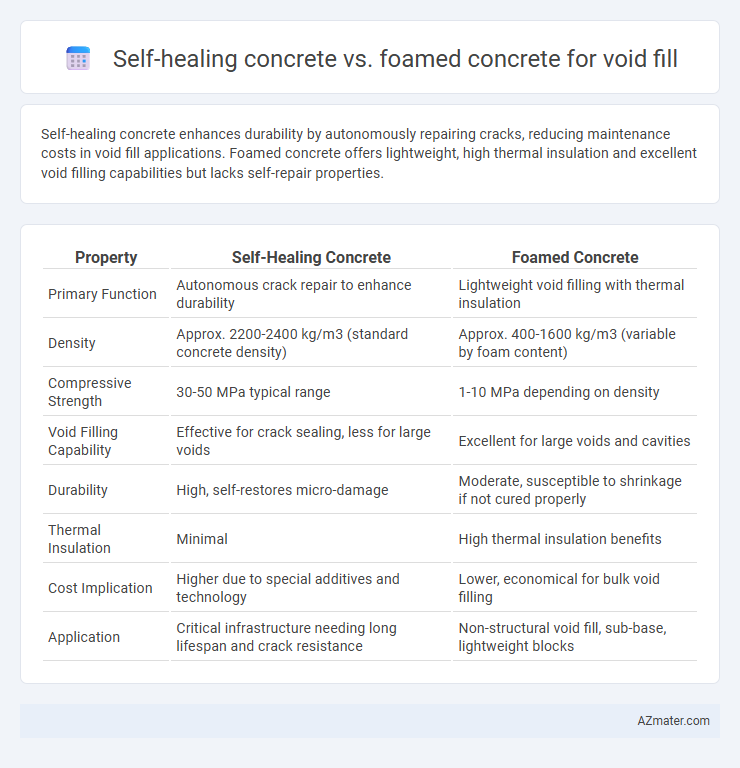Self-healing concrete enhances durability by autonomously repairing cracks, reducing maintenance costs in void fill applications. Foamed concrete offers lightweight, high thermal insulation and excellent void filling capabilities but lacks self-repair properties.
Table of Comparison
| Property | Self-Healing Concrete | Foamed Concrete |
|---|---|---|
| Primary Function | Autonomous crack repair to enhance durability | Lightweight void filling with thermal insulation |
| Density | Approx. 2200-2400 kg/m3 (standard concrete density) | Approx. 400-1600 kg/m3 (variable by foam content) |
| Compressive Strength | 30-50 MPa typical range | 1-10 MPa depending on density |
| Void Filling Capability | Effective for crack sealing, less for large voids | Excellent for large voids and cavities |
| Durability | High, self-restores micro-damage | Moderate, susceptible to shrinkage if not cured properly |
| Thermal Insulation | Minimal | High thermal insulation benefits |
| Cost Implication | Higher due to special additives and technology | Lower, economical for bulk void filling |
| Application | Critical infrastructure needing long lifespan and crack resistance | Non-structural void fill, sub-base, lightweight blocks |
Introduction to Void Fill Solutions
Self-healing concrete offers an innovative approach to void fill by autonomously repairing cracks, enhancing structural durability and reducing maintenance costs. Foamed concrete provides an economical and lightweight solution, efficiently filling large voids with improved thermal insulation and fire resistance properties. Both materials address void fill challenges but differ significantly in functionality, longevity, and application scope.
Overview of Self-Healing Concrete
Self-healing concrete incorporates microcapsules or bacteria that activate upon crack formation, enabling autonomous repair and significantly enhancing durability in void fill applications. This innovative material reduces maintenance costs and extends the lifespan of structures by sealing microcracks before they propagate. Compared to foamed concrete, which primarily relies on lightweight cellular structure for void filling, self-healing concrete offers superior performance in crack resistance and structural integrity over time.
Understanding Foamed Concrete
Foamed concrete is a lightweight material composed of cement, water, and stable foam, creating air bubbles that reduce density and enhance thermal insulation properties. This material is highly effective for void filling due to its flowability, low shrinkage, and ability to harden without significant cracking. Unlike self-healing concrete, which incorporates bacteria or chemical agents to repair cracks over time, foamed concrete provides immediate structural support and volume compensation in void spaces.
Key Material Properties Comparison
Self-healing concrete exhibits superior crack repair capabilities due to embedded bacteria or microcapsules that activate upon damage, enhancing durability and longevity in void filling applications. Foamed concrete, characterized by low density and high compressive strength, provides excellent thermal insulation and ease of application but lacks autonomous repair mechanisms. Key material properties comparison reveals that self-healing concrete offers higher tensile strength recovery and reduced permeability, while foamed concrete excels in lightweight structure support and rapid setting time for void fill.
Installation Processes and Techniques
Self-healing concrete employs microcapsules or bacteria that activate upon crack formation, allowing for autonomous repair during the installation process, which requires precise mixing and placement to ensure effective healing agent distribution. Foamed concrete, characterized by its lightweight, aerated structure, is pumped or poured as a flowable slurry into voids, relying on controlled expansion and curing to fill spaces efficiently without the need for vibration. Installation of self-healing concrete demands careful quality control to maintain viability of healing agents, whereas foamed concrete benefits from simpler, faster placement techniques suitable for large-scale void filling applications.
Durability and Longevity in Void Fill
Self-healing concrete incorporates microcapsules or bacteria that activate upon crack formation, significantly enhancing durability by autonomously repairing damage and preventing void expansion over time. Foamed concrete, characterized by its lightweight and porous structure, offers effective void fill but is more prone to degradation and reduced longevity due to moisture absorption and lower compressive strength. For void fill applications requiring extended service life and resistance to environmental stressors, self-healing concrete provides superior durability and long-term performance compared to foamed concrete.
Cost Analysis: Self-Healing vs Foamed Concrete
Self-healing concrete incurs higher initial costs due to advanced materials like microcapsules or bacteria integration, whereas foamed concrete offers more affordable raw materials and simpler production processes. Long-term expenses for self-healing concrete may decrease owing to reduced maintenance and repair needs, contrasting with foamed concrete's potential for recurring void fill maintenance. Cost analysis must weigh upfront investment against lifecycle savings, favoring self-healing concrete in high durability and performance requirements while foamed concrete suits budget-constrained, short-term applications.
Environmental Impact and Sustainability
Self-healing concrete reduces maintenance frequency and extends lifespan by autonomously repairing cracks, significantly lowering resource consumption and carbon emissions over time. Foamed concrete, made with air bubbles for lightweight void fill, offers thermal insulation and uses less cement, decreasing environmental impact compared to traditional concrete. Both materials contribute to sustainability by minimizing waste and enhancing structural durability, yet self-healing concrete leads in lifecycle carbon footprint reduction due to its reparative capabilities.
Application Suitability for Different Projects
Self-healing concrete offers superior durability and crack repair capabilities, making it ideal for infrastructure projects requiring long-term maintenance reduction such as bridges and tunnels. Foamed concrete provides lightweight, cost-effective void filling with excellent thermal insulation, suitable for non-structural applications like road sub-bases and building foundations. Project requirements for load-bearing capacity and exposure to environmental stressors drive the selection between self-healing and foamed concrete void fill solutions.
Future Trends in Void Fill Concrete Technologies
Self-healing concrete is emerging as a transformative solution for void fill applications, leveraging embedded microcapsules or bacteria that autonomously repair cracks, thereby enhancing structural durability and reducing maintenance costs. Foamed concrete remains popular for lightweight void filling due to its excellent flowability and thermal insulation properties, but its long-term performance is being challenged by innovations in self-healing materials. Future trends emphasize the integration of smart, sustainable composites combining self-healing capabilities with optimized density and strength, driven by advances in nanotechnology and bio-concrete formulations, aiming to revolutionize void fill solutions with enhanced resilience and environmental benefits.

Infographic: Self-healing concrete vs Foamed concrete for Void fill
 azmater.com
azmater.com